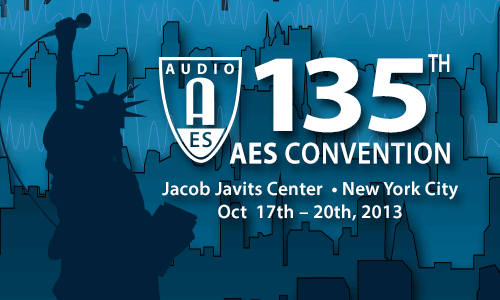
AES New York 2013
Engineering Brief EB3
EB3 - E-Brief Posters—Part 1
Friday, October 18, 5:00 pm — 6:30 pm (1EFoyer)
EB3-1 A Special Room for 3D Audio and Ultra High Definition Video for Quality Assessment of Future TV—Matthieu Parmentier, francetélévisions - Paris, France
francetélévisions, the French public broadcaster, is involved in collaborative projects that aim to embrace the future of television. Ultra High Definition video in conjunction with 3D sound are today explored within the range of content production, techniques, costs, and quality of experience for consumer applications. With its new-dedicated room, the innovations & developments department of francetélévisions has built a necessary tool to drive its strategy for facing the upcoming challenges.
Engineering Brief 112 (Download now)
EB3-2 Real-Time Head-Related Impulse Response Filtering with Distance Control—Julian Villegas, University of Aizu - Aizu Wakamatsu, Fukushima, Japan; Michael Cohen, University of Aizu - Aizu Wakamatsu-shi, Fukashima-ken, Japan
We present a new software application based on a recently collected HRIR database comprising measurements at different distances. The new application, programmed in Pure-data, is capable of directionalizing sound objects at any azimuth, at elevations between -40 degrees and 90 degrees, and at distances 20-160 cm. This truly 3D spatialization is done by pre-calculating the minimum-phase version of the HRIRs and computing the interpolation of a maximum of four HRIR measurements, depending upon the virtual location. In the same way, interaural time differences are computed and applied to the convolved signal. For demanding real-time constraints, the number of taps used for the convolution can be adjusted, up to a maximum of 1024.
Engineering Brief 113 (Download now)
EB3-3 Results on Automated Tuning of a Voice Quality Enhancement System Using Objective Quality Measures—Daniele Giacobello, Beats By Dr. Dre - Santa Monica, CA, USA; Joshua Atkins, Beats Electronics, LLC - Santa Monica, CA, USA; Jason Wung, Beats Electronics, LLC - Santa Monica, CA, USA; Raghavendra Prabhu, Beats by Dr. Dre - Santa Monica, CA, USA
In this work we present a formal procedure for automating the tuning of the various parameters comprising a voice quality enhancer. First, we formalize the problem of tuning as a large-scale nonlinear programming problem. Second, we evaluate the performance of perceptual objective quality measures as optimization criteria for our tuning problem. We then perform a subjective quality assessment to compare the output of a voice enhancer obtained with parameters calculated with these different criteria and also with those obtained through a conventional approach of tuning by expert listening. The results show that using this automated methodology performs well in finding reasonable solutions for the tuning problem, potentially saving time and resources over manual evaluation and tuning.
Engineering Brief 114 (Download now)
EB3-4 Influence of Loudspeaker Systems on Acquisition of Head-Related Transfer Functions—Shouichi Takane, Akita Prefectural University - Yurihonjo, Akita, Japan; Koji Abe, Akita Prefecture University - Yurihonjo, Akita, Japan; Kanji Watanabe, Akita Prefecture University - Yurihonjo, Akita, Japan; Sojun Sato, Akita Prefecture University - Yurihonjo, Akita, Japan
HHead-Related Transfer Function (HRTF) is defined by the ratio of sound pressure at the center of the head without listener and the one at his/her ear. Frequency characteristics of a sound source ought to be cancelled in its acquisition based on this definition, but they are not when the sound sources are spatially distributed such as conventional multiple-driver loudspeaker systems. In this e-brief such influence was investigated by using the HRTFs acquired with various types of loudspeaker systems. As a result, it was found that the HRTFs acquired with four types of loudspeakers roughly agreed when the distance from the sound source is 1.5 m and farther.
Engineering Brief 115 (Download now)
EB3-5 Application of Audio Engineering and Psychoacoustic Principles to Audible Medical Alarms—Christopher Bennett, University of Miami - Coral Gables, FL, USA; Oygo Sound LLC - Miami, FL, USA; Colby N. Leider, University of Miami - Coral Gables, FL, USA; Richard McNeer, University of Miami - Miami, FL, USA
Audible medical alarms standards have recently undergone extensive review by regulatory and safety organizations due to reported ineffectiveness of alarms and the role of “alarm fatigue” in contributing to morbidity and mortality among patients. Many of the problems associated with alarm fatigue stem from an improper application of psychoacoustic and audio engineering principles and naive design of auditory streams that lead to poor segregation, confusion among clinicians, and ultimately fatigue. The audio engineer has a clear role in defining solutions to problems arising in hospital units, some of which have previously been addressed in sound production, sound design, and auditory scene analysis. The roles of sonification, psychoacoustics, and sound perception are discussed as they apply to audible medical alarms.
Engineering Brief 116 (Download now)
EB3-6 Revisiting the Space—Applying 5.1 Surround Sound—Mike Godwin, University of Western Ontario - London, ON, Canada
Origins of this project grew from requests from Faculty and Performers wishing there was a way to better experience the live acoustic again while listening to our archival recordings. As such, my objective was to research an approach to record one of our early music choirs performing in an ambient venue utilizing 5.1 surround techniques. Then through listening tests, obtain subject preferences for the stereo vs. 5.1 versions with comment categories for each. For this project the goal was to use the simplest possible setup as we are most often in a live concert environment, and where setup time is also a consideration. Initially I did recordings testing both cardioid and omni microphones to decide on the best patterns, and placements.
Engineering Brief 117 (Download now)
